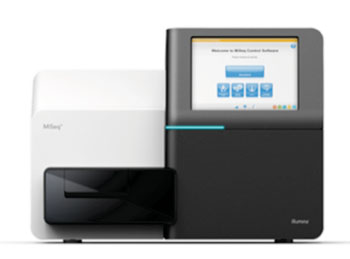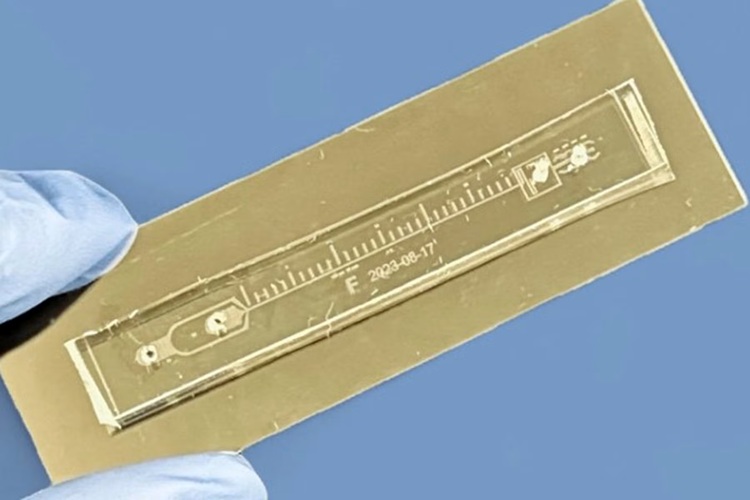Shotgun Metagenomic Technique Detects Tuberculosis Bacteria in Patient Samples Without Culture or Enrichment
|
By LabMedica International staff writers Posted on 15 Oct 2014 |
Infectious disease researchers have developed a new approach for the diagnosis of tuberculosis (TB) that relies on shotgun metagenomics, a method for direct sequencing of DNA extracted from sputum samples, which detects and characterizes the Mycobacterium that cause TB without the need for time-consuming culture or enrichment.
Metagenomics is the study of genetic material recovered directly from environmental samples. In metagenomic sequencing, DNA is recovered directly from environmental samples in an untargeted manner with the goal of obtaining an unbiased sample from all genes of all members of the community. Recent studies used shotgun Sanger sequencing or pyrosequencing to recover the sequences of the reads. Shotgun sequencing is a sequencing method designed for analysis of DNA sequences longer than 1,000 base pairs, up to and including entire chromosomes. This method requires the target DNA to be broken into random fragments. After sequencing individual fragments, the sequences can be reassembled on the basis of their overlapping regions
Investigators at Warwick Medical School (United Kingdom) explored the potential of shotgun metagenomics to detect and characterize strains from the Mycobacterium tuberculosis complex in smear-positive sputum samples. To this end, they analyzed eight samples obtained from tuberculosis patients from Gambia.
The concentration of DNA present in each extract was determined using the Qubit (Invitrogen Ltd., Paisley, United Kingdom) 2.0 fluorometer and Qubit dsDNA Assay Kits according to the manufacturer’s protocol using the HS (high-sensitivity) or BR (broad-range) kits, depending on the DNA concentration. There was no detectable DNA in the negative control samples with the HS kit, which is sensitive down to 10 picograms per microliter. DNA extracts were diluted to 0.2 nanograms per microliter and were then converted into sequencing libraries using the Illumina (Little Chesterford, United Kingdom) Nextera XT sample preparation kit. The libraries were sequenced on the Illumina MiSeq instrument at the University of Warwick.
Using this methodology, the investigators were able to detect sequences from the M. tuberculosis complex in all eight samples, with coverage of the H37Rv reference genome ranging from 0.002X to 0.7X. By analyzing the distribution of large sequence polymorphisms (deletions and the locations of the insertion element IS6110) and single nucleotide polymorphisms (SNPs), they were able to assign seven of eight metagenome-derived genomes to a species and lineage within the M. tuberculosis complex. Two metagenome-derived mycobacterial genomes were assigned to M. africanum, a species largely confined to West Africa; the others that could be assigned belonged to lineages T, H, or LAM within the clade of "modern" M. tuberculosis strains.
"Laboratory diagnosis of TB using conventional approaches is a long drawn-out process, which takes weeks or months," said senior author Dr. Mark Pallen, professor of microbial genomics at Warwick Medical School. "Plus, relying on laboratory culture means using techniques that date back to the 1880s! Metagenomics using the latest high-throughput sequencing technologies and some smart bioinformatics, allows us to detect and characterize the bacteria that cause TB in a matter of a day or two, without having to grow the bacteria, while also giving us key insights into their genome sequences and the lineages that they belong to. We have provided proof-of-principle here, but we still need to make metagenomics more sensitive and improve our workflows. But, caveats aside, let us celebrate the fact that metagenomics stands ready to document past and present infections, shedding light on the emergence, evolution, and spread of microbial pathogens."
The shotgun metagenomics study was published in the September 23, 2014, online edition of the journal PeerJ.
Related Links:
Warwick Medical School
Invitrogen Ltd.
Illumina
Metagenomics is the study of genetic material recovered directly from environmental samples. In metagenomic sequencing, DNA is recovered directly from environmental samples in an untargeted manner with the goal of obtaining an unbiased sample from all genes of all members of the community. Recent studies used shotgun Sanger sequencing or pyrosequencing to recover the sequences of the reads. Shotgun sequencing is a sequencing method designed for analysis of DNA sequences longer than 1,000 base pairs, up to and including entire chromosomes. This method requires the target DNA to be broken into random fragments. After sequencing individual fragments, the sequences can be reassembled on the basis of their overlapping regions
Investigators at Warwick Medical School (United Kingdom) explored the potential of shotgun metagenomics to detect and characterize strains from the Mycobacterium tuberculosis complex in smear-positive sputum samples. To this end, they analyzed eight samples obtained from tuberculosis patients from Gambia.
The concentration of DNA present in each extract was determined using the Qubit (Invitrogen Ltd., Paisley, United Kingdom) 2.0 fluorometer and Qubit dsDNA Assay Kits according to the manufacturer’s protocol using the HS (high-sensitivity) or BR (broad-range) kits, depending on the DNA concentration. There was no detectable DNA in the negative control samples with the HS kit, which is sensitive down to 10 picograms per microliter. DNA extracts were diluted to 0.2 nanograms per microliter and were then converted into sequencing libraries using the Illumina (Little Chesterford, United Kingdom) Nextera XT sample preparation kit. The libraries were sequenced on the Illumina MiSeq instrument at the University of Warwick.
Using this methodology, the investigators were able to detect sequences from the M. tuberculosis complex in all eight samples, with coverage of the H37Rv reference genome ranging from 0.002X to 0.7X. By analyzing the distribution of large sequence polymorphisms (deletions and the locations of the insertion element IS6110) and single nucleotide polymorphisms (SNPs), they were able to assign seven of eight metagenome-derived genomes to a species and lineage within the M. tuberculosis complex. Two metagenome-derived mycobacterial genomes were assigned to M. africanum, a species largely confined to West Africa; the others that could be assigned belonged to lineages T, H, or LAM within the clade of "modern" M. tuberculosis strains.
"Laboratory diagnosis of TB using conventional approaches is a long drawn-out process, which takes weeks or months," said senior author Dr. Mark Pallen, professor of microbial genomics at Warwick Medical School. "Plus, relying on laboratory culture means using techniques that date back to the 1880s! Metagenomics using the latest high-throughput sequencing technologies and some smart bioinformatics, allows us to detect and characterize the bacteria that cause TB in a matter of a day or two, without having to grow the bacteria, while also giving us key insights into their genome sequences and the lineages that they belong to. We have provided proof-of-principle here, but we still need to make metagenomics more sensitive and improve our workflows. But, caveats aside, let us celebrate the fact that metagenomics stands ready to document past and present infections, shedding light on the emergence, evolution, and spread of microbial pathogens."
The shotgun metagenomics study was published in the September 23, 2014, online edition of the journal PeerJ.
Related Links:
Warwick Medical School
Invitrogen Ltd.
Illumina
Read the full article by registering today, it's FREE! 

Register now for FREE to LabMedica.com and get access to news and events that shape the world of Clinical Laboratory Medicine. 
- Free digital version edition of LabMedica International sent by email on regular basis
- Free print version of LabMedica International magazine (available only outside USA and Canada).
- Free and unlimited access to back issues of LabMedica International in digital format
- Free LabMedica International Newsletter sent every week containing the latest news
- Free breaking news sent via email
- Free access to Events Calendar
- Free access to LinkXpress new product services
- REGISTRATION IS FREE AND EASY!
Sign in: Registered website members
Sign in: Registered magazine subscribers
Latest Microbiology News
- Rapid Assay Identifies Bloodstream Infection Pathogens Directly from Patient Samples
- Blood-Based Molecular Signatures to Enable Rapid EPTB Diagnosis
- 15-Minute Blood Test Diagnoses Life-Threatening Infections in Children
- High-Throughput Enteric Panels Detect Multiple GI Bacterial Infections from Single Stool Swab Sample
- Fast Noninvasive Bedside Test Uses Sugar Fingerprint to Detect Fungal Infections
- Rapid Sepsis Diagnostic Device to Enable Personalized Critical Care for ICU Patients
- Microfluidic Platform Assesses Neutrophil Function in Sepsis Patients
- New Diagnostic Method Confirms Sepsis Infections Earlier
- New Markers Could Predict Risk of Severe Chlamydia Infection
- Portable Spectroscopy Rapidly and Noninvasively Detects Bacterial Species in Vaginal Fluid
- CRISPR-Based Saliva Test Detects Tuberculosis Directly from Sputum
- Urine-Based Assay Diagnoses Common Lung Infection in Immunocompromised People
- Saliva Test Detects Implant-Related Microbial Risks
- New Platform Leverages AI and Quantum Computing to Predict Salmonella Antimicrobial Resistance
- Early Detection of Gut Microbiota Metabolite Linked to Atherosclerosis Could Revolutionize Diagnosis
- Viral Load Tests Can Help Predict Mpox Severity
Channels
Clinical Chemistry
view channel
Chemical Imaging Probe Could Track and Treat Prostate Cancer
Prostate cancer remains a leading cause of illness and death among men, with many patients eventually developing resistance to standard hormone-blocking therapies. These drugs often lose effectiveness... Read more
Mismatch Between Two Common Kidney Function Tests Indicates Serious Health Problems
Creatinine has long been the standard for measuring kidney filtration, while cystatin C — a protein produced by all human cells — has been recommended as a complementary marker because it is influenced... Read moreMolecular Diagnostics
view channel
New Genetic Test Enables Faster Diagnosis of Rare Diseases
Rare disease diagnosis often involves a long and uncertain search for the underlying genetic cause. Traditional testing requires multiple separate analyses, although many patients remain without answers.... Read more
Urine Test Detects Inherited Neuropathy Missed by Genetic Screening
Sorbitol dehydrogenase (SORD)-related neuropathy is one of the most common inherited nerve disorders, yet diagnosis often lags because current genetic screens frequently miss the causal gene.... Read moreHematology
view channel
Platelet Activity Blood Test in Middle Age Could Identify Early Alzheimer’s Risk
Early detection of Alzheimer’s disease remains one of the biggest unmet needs in neurology, particularly because the biological changes underlying the disorder begin decades before memory symptoms appear.... Read more
Microvesicles Measurement Could Detect Vascular Injury in Sickle Cell Disease Patients
Assessing disease severity in sickle cell disease (SCD) remains challenging, especially when trying to predict hemolysis, vascular injury, and risk of complications such as vaso-occlusive crises.... Read more
ADLM’s New Coagulation Testing Guidance to Improve Care for Patients on Blood Thinners
Direct oral anticoagulants (DOACs) are one of the most common types of blood thinners. Patients take them to prevent a host of complications that could arise from blood clotting, including stroke, deep... Read moreImmunology
view channel
Chip Captures Cancer Cells from Blood to Help Select Right Breast Cancer Treatment
Ductal carcinoma in situ (DCIS) accounts for about a quarter of all breast cancer cases and generally carries a good prognosis. This non-invasive form of the disease may or may not become life-threatening.... Read more
Blood-Based Liquid Biopsy Model Analyzes Immunotherapy Effectiveness
Immunotherapy has revolutionized cancer care by harnessing the immune system to fight tumors, yet predicting who will benefit remains a major challenge. Many patients undergo costly and taxing treatment... Read morePathology
view channel
Blood Test and Sputum Analysis Predict Acute COPD Exacerbation
Chronic obstructive pulmonary disease (COPD) remains a major contributor to global illness, largely driven by cigarette smoking and marked by irreversible lung damage. Acute exacerbations can accelerate... Read more
AI Tool to Transform Skin Cancer Detection with Near-Perfect Accuracy
Melanoma continues to be one of the most difficult skin cancers to diagnose because it often resembles harmless moles or benign lesions. Traditional AI tools depend heavily on dermoscopic images alone,... Read more
Unique Immune Signatures Distinguish Rare Autoimmune Condition from Multiple Sclerosis
Myelin oligodendrocyte glycoprotein antibody–associated disease (MOGAD) is a rare autoimmune disorder in which the immune system attacks the myelin sheath in the central nervous system. Although symptoms... Read moreTechnology
view channel
AI Saliva Sensor Enables Early Detection of Head and Neck Cancer
Early detection of head and neck cancer remains difficult because the disease produces few or no symptoms in its earliest stages, and lesions often lie deep within the head or neck, where biopsy or endoscopy... Read more
AI-Powered Biosensor Technology to Enable Breath Test for Lung Cancer Detection
Detecting lung cancer early remains one of the biggest challenges in oncology, largely because current tools are invasive, expensive, or unable to identify the disease in its earliest phases.... Read moreIndustry
view channel
Abbott Acquires Cancer-Screening Company Exact Sciences
Abbott (Abbott Park, IL, USA) has entered into a definitive agreement to acquire Exact Sciences (Madison, WI, USA), enabling it to enter and lead in fast-growing cancer diagnostics segments.... Read more


























